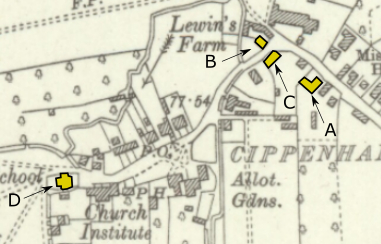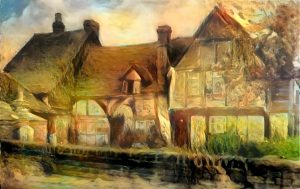Lost buildings of Lower Cippenham Lane
Lower Cippenham Lane is probably the oldest route through Cippenham. It is noteworthy that one end heads from the likely sites of John, Earl of Cornwall’s Cippenham Palace in the direction of the Abbey he founded in Dorney in the year 1266. The features of Cippenham Green Lane as it was once known can be clearly recognised on Rocque’s map of 1764, although there are obvious inaccuracies. It can be seen on the map that even at this time, there were quite a few buildings along the lane. Many interesting historic buildings were lost in the mid-20th century to meet the ever-increasing need for housing. Sadly, little is written or remembered about these constructions. This article is to inform what is known about some of them.

The map shows the locations of some of the buildings in the article. It’s not too difficult to figure out where they all were [but this section will be improved].
 The Gardeners’ Cottages (A). This may have originally been a single house, but by 1912 it was occupied as two separate dwellings and some time after that, as three. Earlier in the Edwardian era the building had operated as a beer house. According to legend it was bought by the Mormons to end the sale of liquor and also because the Jolly Gardeners’ Inn was frequented by “unusual folk”. According to the ‘Monuments of Buckinghamshire’, the upper storey projected at the northwest end and was gabled. At the southeast end was a dormer window with a plastered gable which bore the date 1699. The original building, however, probably dated from the early 1600s. The cottages were in very poor condition and were demolished in 1957 to make way for new housing for the elderly.
The Gardeners’ Cottages (A). This may have originally been a single house, but by 1912 it was occupied as two separate dwellings and some time after that, as three. Earlier in the Edwardian era the building had operated as a beer house. According to legend it was bought by the Mormons to end the sale of liquor and also because the Jolly Gardeners’ Inn was frequented by “unusual folk”. According to the ‘Monuments of Buckinghamshire’, the upper storey projected at the northwest end and was gabled. At the southeast end was a dormer window with a plastered gable which bore the date 1699. The original building, however, probably dated from the early 1600s. The cottages were in very poor condition and were demolished in 1957 to make way for new housing for the elderly.
 Lewin’s Farm The buildings of Lewin’s farm filled the area between Bowyer Drive and Brook Path. The farmhouse (B) was built in the 1700s and faced onto Lower Cippenham Lane. It was a two storey building of brick and tile. The house, along with the 4 barns bordered a rectangular farmyard. One of the barns was reputed to date back to 1320, although this would have been exceptionally early for the type of construction. In the 20th Century, it was technically no longer a farm a farm, because other than the courtyard and buildings, it possessed no land. The buildings were demolished in late 1968. At the time of its demolition, opinion was divided as to whether the farm was picturesque or an eyesore. It had become known also as Neville’s Farm after the family who’d occupied it for the past 40 years. It was best known for its riding stables during this era and hundreds of children were taught to ride.
Lewin’s Farm The buildings of Lewin’s farm filled the area between Bowyer Drive and Brook Path. The farmhouse (B) was built in the 1700s and faced onto Lower Cippenham Lane. It was a two storey building of brick and tile. The house, along with the 4 barns bordered a rectangular farmyard. One of the barns was reputed to date back to 1320, although this would have been exceptionally early for the type of construction. In the 20th Century, it was technically no longer a farm a farm, because other than the courtyard and buildings, it possessed no land. The buildings were demolished in late 1968. At the time of its demolition, opinion was divided as to whether the farm was picturesque or an eyesore. It had become known also as Neville’s Farm after the family who’d occupied it for the past 40 years. It was best known for its riding stables during this era and hundreds of children were taught to ride.
On the opposite side of the lane to Lewin’s farm was once three-storey smithey that possibly dated back to the 1600s (C). It leaned to one side and relied on a Victorian terrace for support. On the ground floor there were stables, which were lived in by a family in the forties. The top floor was said haunted by an apprentice who was kept prisoner there and starved to death by the blacksmith for reasons unknown. The building was pulled down in the late 50s.
Cippenham Green Mission Chapel and School (D). Built some time prior to 1876, there were once a C of E chapel and school at the junction between Lower Cippenham Lane and Millstream Lane. The school was superseded by the one built in Elmshott Lane in the late 1930s. The buildings were demolished in the late 1940s. This photograph looks across Lower Cippenham Lane. Millstream Lane is just out of shot on the right. On the far left the “tin church” can be seen. Constructed from corrugated iron his stood until the 1980s and was used by the Reorganised Church of Jesus Christ of Latter Day Saints (an offshoot from the Mormons).
Ordnance Survey image reproduced with the permission of the National Library of Scotland under Creative Commons license. Map Images Website https://maps.nls.uk/index.html






The middle one of Gardeners Cottage was occupied by granny Godding she was my
gt grandmother, my dad was born there (being the oldest) and when his parents moved out he stayed until he married and bought house in Ivy Cres, his parents rented a place nearby in Cippenham Lane and had a further 10 kids! Dad lived with aunts Ethel and Ruth and uncle Harry (he’d been a stretcher bearer in WWI, always led the Cippenham Remembrance parade, carried the flag, grandad (Bill Hill) walked beside him, Harry talked my dad into doing his St Johns)Dad hated the old house, low beams, death watch beetle, old well next to privy etc, loved new house in Ivy Cres, was always in the bathroom, washing, I used to meet mum at grans house from Cippenham school on a Tuesday. Dad could remember range going in, before it been a chimley corner (you could see stars up the chimney) prob the reason mum went there, we couldn’t afford a fire in the afternoon at home and he could remember water pump going in front garden (I used to play with it but it wouldn’t pump water any more, they had mains I spose) I used to stand by front wall and watch traffic, I remember 3rd coping along was glazed. Inside was one long room with a step and a curtain across the middle, I realise now it smelt of beer, the step was prob where they stood the barrels. Family business pulled it down, Albert Hill was my 2nd youngest uncle, my bro was his driver, I worked weekends & hols, we got £5 cwt for old beams, prob went into mock tudor houses somewhere
It was Lewins to my dad, Nevilles to us. Mum was horrified one day, she went over there for eggs, there were hens in the kitchen, roosting on the back of chairs! We followed Mr Neville about on his milk round (his horse urinated a river!), when he came back his wife said Mrs SoandSo wanted gold top, he had supply of tops in his barn, he took the silver top off and put gold top on! Neville kept pigs out the back. Mrs Neville commentated a gymkhana on Weeks field (opp. Spring Lane)
My dad went to the school on the corner of Millstream Lane, (I think I sent a report card of his to Slough Museum), amused us, it was a pig farm when we were kids! Didn’t the “tin tabernacle” survive a while, used by the football club?